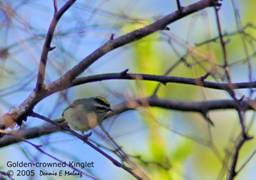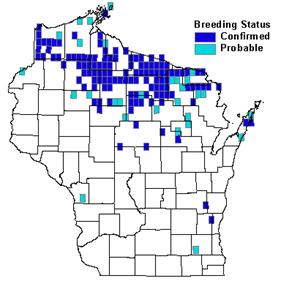Photo by Dennis Malueg


Status/Protection
- Global Rank: G5 Key to global and state ranks
- State Rank: S3B, SZN
- WBCI Priority: None
Population Information
The Federal BBS information can be obtained at http://www.mbr-pwrc.usgs.gov/bbs/bbs.html by clicking on Trend Estimates and selecting the species in question. All estimates are for time period (1966-2005).
- Federal Breeding Bird Survey: significant decrease
- Federal Breeding Bird Survey (WI): stable
- Federal Breeding Bird Survey (BCR 23): NA
- Federal Breeding Bird Survey (BCR 12): non-significant decline
- Chequamegon National Forest Bird Survey (NRRI): non-significant decline (1992-2005)
- WSO Checklist Project: increasing (Temple et al. 1997)
Life History
- Breeding Habitat: Fir-Spruce, Swamp Conifer-Balsam Fir, Black Spruce.
- Nest: pendant; in conifer (Ehrlich et al. 1988, Ingold and Galati 1997).
- Nesting Dates: mid May – mid July across N. American range (Ingold and Galati 1997).
- Foraging: foliage glean, hover and glean, hawks (Ehrlich et al. 1988).
- Migrant Status: Short-distance migrant.
- Habitat use during Migration: coniferous forests, mixed forests, deciduous forests, parks, gardens, fencerows, oldfields (Ingold and Galati 1997).
- Arrival Dates: some individuals overwinter; migrants arrive mid March – early May (Robbins 1991).
- Departure Dates: mid September – mid October (Robbins 1991).
- Winter Range: western North America from AK through mountains to Mexico; throughout Great Plains states in winter except MT and ND; throughout remainder of lower 48 except peninsular FL (Ingold and Galati 1997).
- Winter Habitat: both coniferous and deciduous forests and woodlands, forest edge (Ingold and Galati 1997).
Habitat Selection
The Golden-crowned Kinglet forages at the tips of branches, along main branches and trunks of trees, in coniferous forests during the breeding season, and in other forest types during migration and winter. In winter it also forages among dead leaves still found on trees of many species. Its foraging niche is thus very similar to its congener, the Ruby-crowned Kinglet, and to the Black-capped Chickadee. Soft-bodied insect prey and egg masses form a large proportion of its food during summer, migration, and (dormant insects) in winter. The GCKI uses all height levels in forests for foraging, except the groundlayer.
Nests are built in spruces and balsam fir, suspended from small branches. Nests are situated from 8-20 meters (25-65 feet) in height above ground. The nest is well-concealed amid foliage.
GCKI do not survive harsh winters; those individuals staying at the northern edge of the winter range perish if temperatures go far below freezing for extended periods. Highest densities in winter are found in areas with moderate temperatures. However, small numbers do persist throughout WI during most winters. CBC numbers for WI average approximately 250 individuals on all CBC circles combined (Ingold and Galati 1997).
Habitat Availability
The Golden-crowned Kinglet uses spruce and fir forests, and parts of other forest types (both deciduous and coniferous - having spruce components) for breeding. The GCKI has expanded its range in response to the planting of spruces (Ingold and Galati 1997). In Wisconsin, most breeding is confined to the northernmost counties, with a few exceptions in managed forests of the north-central and southeastern parts of the state (WBBA website 2003). In the Chequamegon National Forest, for example, this species attains its highest abundance in saw-timber age red pine, pole age quaking aspen, and mixed swamp conifers (Chequamegon NF abundance data http://oden.nrri.umn.edu/mnbirds/Data/getrecords.asp).
Population Concerns
The Golden-crowned Kinglet is declining in the western part of its range, but increasing in the east (Ingold and Galati 1997), including some parts of Wisconsin. CBC results for the past 20 years in WI have fluctuated considerably, but show no marked decline (see http://audubon2.org/birds/cbc/hr/graph.html ).
Recommended Management
No specific management recommendations are necessary for the Golden-crowned Kinglet. Although it is negatively affected by logging in some areas, (Ingold and Galati 1997) habitat in some parts of Wisconsin is actually increasing for this species, with additional plantings of spruces as well as the natural succession of deciduous tree dominated forests to mixed deciduous- fir-spruce forest communities. As recently as the late 1980s, Robbins had found no confirmed records of breeding in WI for this species, in preparation for Wisconsin Birdlife (1991), but field work for the Wisconsin Breeding Bird Atlas found breeding pairs in many of Wisconsin’s northern counties (see WBBA map).
Research Needs
A great deal remains to be learned about Golden-crowned Kinglet life history and ecology. Information on aspects of breeding, pair formation, and nest site selection. Migration studies are also needed, with gaps in knowledge of distances migrated, migratory physiology, and where our wintering individuals originate (Ingold and Galati 1997).
Information Sources
- The Wisconsin Breeding Bird Atlas http://www.uwgb.edu/birds/wbba/
- NRRI website http://oden.nrri.umn.edu/mnbirds/newaccounts/GCKIa2.htm
- Nicolet NF bird survey habitat/species group map http://www.uwgb.edu/birds/nnf/mlcfbirds.htm
- Nicolet NF bird survey species map http://www.uwgb.edu/birds/nnf/species/GCKI.htm
- Chequamegon NF abundance data http://oden.nrri.umn.edu/mnbirds/Data/getrecords.asp
- Christmas Bird Count data for 1982-83 to 2002-03 (or any selected time period) http://audubon2.org/birds/cbc/hr/graph.html
References
- Askins, R. A. 2000. Restoring North America’s birds: lessons from landscape ecology. Yale Univ. Press, New Haven, CN.
- DeGraaf, R.M., and J.H. Rappole. 1995. Neotropical migratory birds: natural history, distribution, and population change. Comstock Publ. Assoc., Cornell Univ. Press, Ithaca, NY.
- Ehrlich, P.R., D.S. Dobkin, and D. Wheye. 1988.The birders handbook: a field guide to the natural history of North American birds. Simon & Schuster, Inc. New York.
- Ingold, J.L., and R. Galati. 1997. Golden-crowned Kinglet (Regulus satrapa). In The Birds of Naorth America, No. 301 (A. Poole and F. Gill, eds.). The Academy of Natural Sciences, Philadelphia, PA, and the American Ornithologists’ Union, Washington, D.C.
- Price, J., S. Droege, and A. Price. 1995. The summer atlas of North American birds. Academic Press, New York.
- Rappole, J.H. 1995. The ecology of migrant birds. Smithsonian Institution Press, Washington, D.C.
- Robbins, S. D. 1991. Wisconsin birdlife: population & distribution, past & present. Univ. of Wisconsin Press, Madison, WI.
- Wisconsin Society for Ornithology. 1995. Wisconsin breeding bird atlas; atlasing handbook 1995-1999. Wisconsin Society for Ornithology, Inc., Hartland, WI.
Contact Information
- Compiler: William P. Mueller, 414-643-7279, iltlawas@earthlink.net
- Editor: Jim Baughman, 715-479-8870, james.baughman@dnr.state.wi.us
